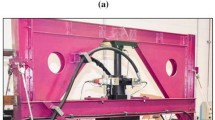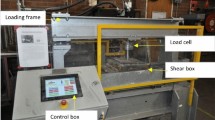Abstract
Neoballast, consisting of natural aggregates coated with rubber particles from waste tires, is postulated as an alternative type of ballast that can show higher resistance to breakage and frictional wear. However, as this innovative material also aims to improve track performance and durability, its application could lead to variations in fundamental track properties such as vertical stiffness, damping capacity, and settlement. This paper focuses on analyzing the effect of Neoballast on track section behavior as well as the optimization of its design in order to obtain deflections that are comparable to those measured with traditional ballast over both stiff and soft substructures. Results reflect that Neoballast allows for higher damping capacity, reduction in stress, and lower long-term settlement. Nonetheless, it leads to lower vertical stiffness, and therefore reduced thickness for this granular layer is required.









Similar content being viewed by others
References
Esveld C (1989) Modern railway track. MRT Productions, Duisburg
Ionescu D (2004) Evaluation of the engineering behaviour of railway ballast. PhD Dissertation, University of Wollongong, Australia
Lim WL (2004) Mechanics of railway ballast behaviour. PhD. Dissertation, University of Nottingham, UK
Selig ET, Waters JM (1994) Track geotechnology and substructure management. Thomas Telford, London
McMichael P, McNaughton A (2003) The stoneblower—delivering the promise. Development, testing and operation of a new track maintenance system. In: 82nd annual meeting. Transortation Research Board, Washington
Selig E (1999) Stoneblowing principles. University of Massachusetts, Boston
Sol-Sánchez M, Moreno-Navarro F, Rubio-Gámez MC (2016) Analysis of ballast tamping and stone-blowing processes on railway track behaviour: the influence of using USPs. Géotechnique 66:481–489
Chrismer SM (1989) Ballast renewal model user’s manual
Manzo N, López-Pita A, Fontsere V, Ausilio A, De Ambri E, Basei E (2015) NEOBALLAST: seeking for the ballast of the future. In: Proceedings of third international conference of railway technology, Cagliari, Italy, pp 3–4
Diego S, Casado JA, Carrascal I, Ferreño D, Cardona J, Arco R (2017) Numerical and experimental characterization of the mechanical behaviour of a new recycled elastomer vibration isolation in railway applications. Constr Build Mater 134:18–31
Magnoni M, Toraldo E, Giustozzi F, Crispino M (2016) Recycling practices for airport pavement construction: valorisation of on-site materials. Constr Build Mater 112:59–68
Moreno-Navarro F, Sol-Sánchez M, Rubio-Gámez MC (2014) Reuse of deconstructed tires as anti-reflective cracking mat systems in asphalt pavements. Constr Build Mater 53:182–189
D’Angelo G, Thom N, Lo Presti D (2016) Bitumen statilized ballast: a potential solution for railway track-bed. Constr Build Mater 124:118–126
Sol-Sánchez M, Pirozzolo L, Moreno-Navarro F, Rubio-Gámez MC (2016) A study into the mechanical performance of different configurations for the railway track section: a laboratory approach. Eng Struct 119:13–23. https://doi.org/10.1016/j.engstruct.2016.04.008
Fontserè V, López Pita A, Manzo N, Ausilio A (2016) NEOBALLAST: new high-performance and long-lasting ballast for sustainable railway infrastructures. Transp Res Procedia 14:1847–1854
Morales-Ivorra S, Real JI, Hernández C, Montalbán L (2016) Derailment risk and dynamics of railway vehicles in curved tracks: analysis of the effect of failed fasteners. J Mod Transp 24:38–47
Bach H, Veit P (2013) Evaluation of attrition tests for railway ballast. PhD Dissertation, Graz University of Technology, Austria
Indraratna B, Khabbaz H, Salim W, Christie D (2006) Geotechnical properties of ballast and the role of geosynthetics. J Ground Improvement 19:91–102
Sol-Sánchez M, Moreno-Navarro F, Martínez-Montes G, Rubio-Gámez MC (2017) An alternative sustainable railway maintenance technique based on the use of rubber particles. J Clean Prod 142:3850–3858
López Pita A (2006) Infraestructuras ferroviarias. Edicions UPC, Barcelona
Marshal RJ (1967) Large scale testing of rockfill materials. J Soil Mech Found Eng ASCE 93(SM2):27–43
Indraratna B, Lackenby J, Christie D (2005) Effect of confining pressure on the degradation of ballast under cyclic loading. Geotechnique 55:325–328
Sol-Sánchez M, Moreno-Navarro F, Rubio-Gámez MC (2014) Viability analysis of deconstructed tires as materials for rail pads in high-speed railways. Mater Des 64:407–414
Fortin JP (1982) La deformée dynamique de la voie. Revue generale des Chemins de Fer
Sol-Sánchez M, Thom N, Moreno-Navarro F, Rubio-Gámez MC, Airey GD (2015) A study into the use of crumb rubber in railway ballast. J Constr Build Mater 75:19–24. https://doi.org/10.1016/j.conbuildmat.2014.10.045
Moaveni M, Qian Y, Boler H, Mishra D, Tutumluer E (2014) Investigation of ballast degradation and fouling trends using image analysis. In: Proceedings of the second international conference on railway technology. Research, development and maintenance, Corsica, France
Trinh VN, Tang AM, Cui Y, Dupla J, Canou J, Calon N, Lambert L, Robinet A, Schoen O (2012) Mechanical characterisation of the fouled ballast in ancient railway track substructure by large-scale triaxial tests. Soils Found 52:511–523
Author information
Authors and Affiliations
Corresponding author
Rights and permissions
About this article
Cite this article
Sol-Sánchez, M., Moreno-Navarro, F., Rubio-Gámez, M.C. et al. Full-scale study of Neoballast section for its application in railway tracks: optimization of track design. Mater Struct 51, 43 (2018). https://doi.org/10.1617/s11527-018-1167-2
Received:
Accepted:
Published:
DOI: https://doi.org/10.1617/s11527-018-1167-2




